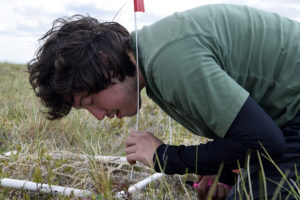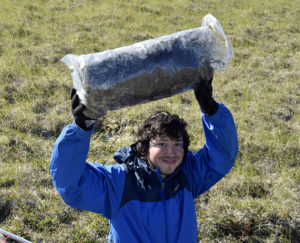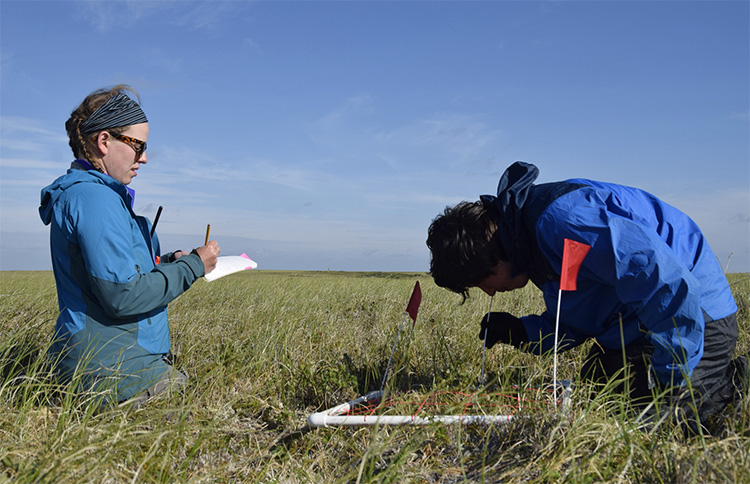The 2017 Polaris Project team spent two weeks studying climate change impact on the tundra of Alaska’s Yukon-Kusksokwim Delta. The team – including students and scientist faculty – returned to the Woods Hole Research Center on July 15 to process the samples they had taken in the field.
By Homero Pena
 I remember being very excited about this trip to the tundra in the Yukon Delta (YK Delta), Alaska. I had taken part in the Polaris Project expedition to the Siberian tundra and I was curious to see how this trip would be different.
I remember being very excited about this trip to the tundra in the Yukon Delta (YK Delta), Alaska. I had taken part in the Polaris Project expedition to the Siberian tundra and I was curious to see how this trip would be different.
In Siberia, we worked in one tundra location that had variations in slope and water availability. The tundra in the YK delta was special because portions of it had experienced a fire in 2015, so we had the ability to study burned and unburned areas. There were also some old burns nearby that had occurred in 1972. From the beginning, I had the idea to focus my project on how vegetation communities would differ between burned and unburned areas in the tundra.
From the get go, this trip did not disappoint. We got our team and our equipment out to the campsite on a float plane, and I was on the third flight. It lasted about an hour and landed on what would be known as “Landing Lake.” Along with the other three passengers (other Polaris Project students) I walked up the bank of the lake, introduced myself to everyone at camp, and spent about an hour setting up the tent I would live in for two weeks. The following day, the rest of the group arrived, and we settled in at dinner with announcements about how the camp would work. The conversation included subjects like meal times, bear safety, leadership, and the occasional awkward joke that was always met with delayed laughter.
 It was go time a couple of days after we all arrived. There was one Polaris Project student, Laura Jardine, who had very similar interests to mine, and so we became team members for our entire stay in the tundra. We broke up into our respective groups and headed out into the tundra with our field gear and enough food and water to keep us alive until dinner. Laura and I hiked out into the tundra, which felt like memory foam that did not push back up as we walked on it. We made it to our first official ‘site’ where we immediately got to work. We started by setting up our site, and then surveying the vegetation by identifying them down to the species level. Laura and I then harvested the vegetation by cutting it out of the ground in what we called a ‘tundra burrito’ that would help us understand how much of each plant was there. Finally, we collected soil organic layer information such as: moisture, temperature, and depth of the soil organic layer among other things. By the end of the two weeks, we had sampled 10 sites.
It was go time a couple of days after we all arrived. There was one Polaris Project student, Laura Jardine, who had very similar interests to mine, and so we became team members for our entire stay in the tundra. We broke up into our respective groups and headed out into the tundra with our field gear and enough food and water to keep us alive until dinner. Laura and I hiked out into the tundra, which felt like memory foam that did not push back up as we walked on it. We made it to our first official ‘site’ where we immediately got to work. We started by setting up our site, and then surveying the vegetation by identifying them down to the species level. Laura and I then harvested the vegetation by cutting it out of the ground in what we called a ‘tundra burrito’ that would help us understand how much of each plant was there. Finally, we collected soil organic layer information such as: moisture, temperature, and depth of the soil organic layer among other things. By the end of the two weeks, we had sampled 10 sites.
I should define some terms: the’ soil organic layer’ is made up of dead vegetation that builds up over time due to cool temperatures in the tundra; most vegetation grows on top of this soil organic layer and contributes to its build up. This soil organic layer then insulates the all-important permafrost soil underneath from warmer air temperatures, and this permafrost is what makes this place so important in the first place. Permafrost soil is soil that has been frozen for two or more consecutive years. The reason we are here is because this place has become increasingly vulnerable to climate warming. Over the decades, warming has reduced the soil organic layer’s ability to insulate these all-important permafrost soils that hold a lot of undecomposed vegetation. If it were to thaw, little microbes can break this dead vegetation down and release carbon dioxide (CO2) as a byproduct, which is a common greenhouse gas that is primarily responsible for the warming that is already occurring. In my research, I want to understand the impact that fire has on the tundra vegetation, and what that means for the permafrost.
It is important that we monitor the tundra and the Arctic so that we know how it is responding to an ever-warming planet, since it has the potential to impact not only Arctic communities, but every single person on the planet, no matter how far away from the Arctic you are.
Homero Pena is a graduate student at Mississippi State University. He will receive a Masters of Science in Forestry in the Fall of 2017. As an undergraduate student, Mr. Pena took part in the 2014 Polaris Project expedition to Siberia.




